
How to Sanitize Outdoor Areas
July 26, 2024
What is Self Disinfecting Coating? (Beginner’s Guide)
September 17, 2024How to Disinfect Fitness Equipment and Exercise Mats

How-to-Disinfect-Fitness-Equipment-and-Exercise-Mats
How to Disinfect Fitness Equipment and Exercise Mats? Maintaining a clean environment in fitness areas is crucial for preventing the spread of infections and ensuring the safety of users.
Fitness equipment and exercise mats frequently come into contact with multiple individuals, making them susceptible to contamination by various germs.
Effective disinfection practices help minimize the risk of infections, ensuring a healthier workout space.
Disinfecting fitness equipment and exercise mats is essential for several reasons. Firstly, these surfaces are exposed to sweat, skin cells, and bodily fluids, which can harbor harmful microorganisms.
Regular disinfection helps to eliminate these pathogens, reducing the risk of infections such as skin conditions, respiratory illnesses, and fungal infections.
This practice not only protects individual health but also enhances the overall hygiene and user experience in fitness environments.
Read on – How to Disinfect Fitness Equipment and Exercise Mats
Overview of Fitness Equipment and Exercise Mats
Types of Equipment
Fitness equipment in gyms and home setups includes a wide range of items. Cardio machines, such as treadmills, ellipticals, and stationary bikes, are commonly used for aerobic workouts.
Strength training equipment includes free weights, weight machines, and resistance bands, which are essential for muscle-building exercises.
Exercise mats, used for activities like yoga, Pilates, and floor exercises, provide a comfortable surface for various workouts.
Materials
The materials used in fitness equipment and mats vary and require different cleaning approaches.
Cardio machines often incorporate plastic and metal components, which are durable but can be sensitive to harsh chemicals.
Strength training equipment, such as weights and bars, typically features metal, while machines may include plastic and rubber parts.
Exercise mats are generally made from PVC, rubber, or foam, each needing specific cleaning methods to avoid damage.
Understanding the Contamination Risks
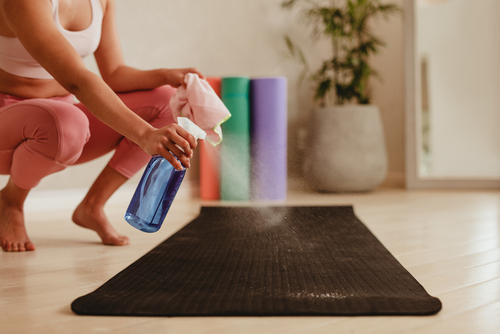
Sources of Contamination
Fitness equipment and mats can become contaminated through direct contact with users.
Sweat is a common source of contamination, providing a medium for bacterial growth. Skin cells and bodily fluids, such as saliva and mucus, can also deposit pathogens onto surfaces.
Shared use of equipment increases the risk of cross-contamination, making regular disinfection essential to maintain hygiene.
Common Pathogens
Several types of pathogens can be found on fitness equipment and mats.
Bacteria such as Staphylococcus aureus can cause skin infections, while viruses like Influenza and Rhinovirus can lead to respiratory illnesses.
Fungi, including those responsible for Athlete’s Foot, thrive in warm, moist environments common in fitness areas.
High-Risk Areas and Equipment
Certain items and areas in gyms are particularly prone to contamination. Free weights, handles, and mats are frequently touched and used by multiple individuals, making them hotspots for microbial buildup.
Cardio machines, with their handles, control panels, and seats, are significant vectors for germ transmission. Identifying these high-touch points and focusing disinfection efforts on them is key to maintaining hygiene.
Choosing the Right Disinfectants
Types of Disinfectants
Selecting the appropriate disinfectant is crucial for effective sanitation.
Chemical disinfectants, such as alcohol-based solutions and quaternary ammonium compounds, are commonly used due to their broad-spectrum efficacy.
Alcohol-based solutions quickly evaporate, making them suitable for surfaces that need to dry fast. Quaternary ammonium compounds are effective against a wide range of pathogens, making them a versatile choice for gym environments.
Natural disinfectants, including vinegar and essential oils, can be used as eco-friendly alternatives. While they may not be as potent as chemical disinfectants, they are suitable for light cleaning and maintenance, especially in home gym settings.
Criteria for Selection
When choosing disinfectants, consider their effectiveness against a broad range of pathogens and their compatibility with the materials of the equipment.
Disinfectants must be potent enough to kill bacteria, viruses, and fungi while being gentle enough not to damage the equipment.
It is also important to select products that are non-toxic and safe for skin contact, particularly for items that come into direct contact with users’ bodies.
Avoid products that leave harmful residues or emit strong fumes, as these can cause respiratory irritation or skin reactions.
Preparing for Disinfection
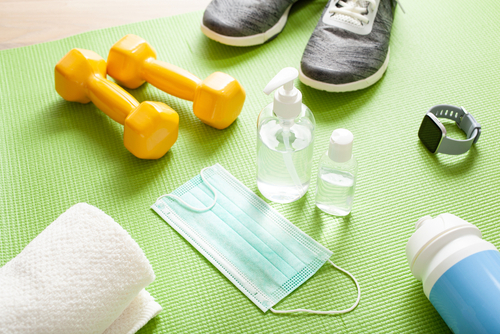
Gathering Supplies
Effective disinfection begins with proper preparation. Gather all necessary supplies, including disinfectants, microfiber cloths, brushes, and personal protective equipment (PPE) such as gloves and masks.
PPE is essential to protect the person disinfecting from exposure to chemicals and contaminants.
Pre-Cleaning Procedures
Before applying disinfectants, it is crucial to clean the equipment to remove any visible dirt and debris.
This step allows the disinfectant to contact the surface directly for maximum efficacy. Use a damp cloth or vacuum for this initial cleaning.
For intricate parts of equipment, such as handles and joints, use brushes to clean hard-to-reach areas. This pre-cleaning ensures that disinfectants can work effectively, unhindered by debris.
Disinfecting Different Types of Fitness Equipment
Cardio Machines
Cardio machines such as treadmills, ellipticals, and stationary bikes are heavily used and require regular disinfection.
Focus on cleaning the handles, control panels, and seats, as these are the areas most frequently touched.
Wipe these parts with disinfectant sprays or wipes, ensuring thorough coverage. Pay attention to the nooks and crannies where sweat and germs can accumulate.
After disinfecting, allow the surfaces to dry completely before the equipment is used again to prevent skin contact with wet disinfectants.
Strength Training Equipment
Strength training equipment includes free weights, weight machines, and resistance bands. These items have multiple touchpoints that need careful disinfection.
Clean the handles and bars of free weights thoroughly with wipes or sprays. For weight machines, focus on the seats, handles, and adjustment levers, ensuring that disinfectants reach all surfaces.
Use products that are safe for metal and plastic to avoid corrosion or degradation. Resistance bands should be wiped down regularly, paying close attention to areas that come into direct contact with users.
Yoga Mats and Exercise Mats
Exercise mats are used directly on the floor and come into contact with various body parts, making them susceptible to contamination.
Different materials such as PVC, rubber, or foam require specific cleaning methods to avoid damage.
Mild soap and water can be used for daily cleaning, while alcohol-based disinfectants can be employed for thorough disinfection.
Spray the disinfectant evenly across the mat surface or use disinfectant wipes, ensuring adequate contact time. Allow the mat to dry completely before rolling or storing it to prevent mold and mildew growth.
Accessories
Smaller accessories such as resistance bands, stability balls, and foam rollers also require regular disinfection.
Use disinfectant wipes or sprays to cover all surfaces, ensuring thorough cleaning of areas that come into direct contact with users.
Pay attention to the ends of resistance bands and the surfaces of stability balls, which are frequently handled. Foam rollers should be wiped down thoroughly, focusing on areas that come into contact with the body.
Application Techniques
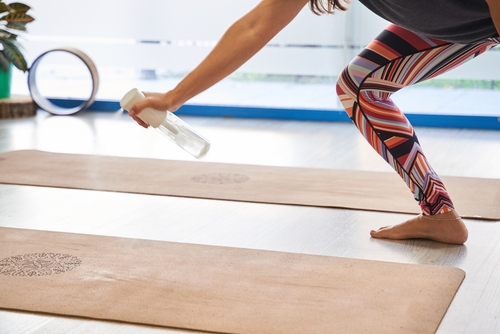
Spraying vs. Wiping
The method of applying disinfectants is crucial for effective cleaning. Spraying is ideal for large surfaces and equipment, ensuring even distribution of the disinfectant.
When using sprays, ensure the entire area is covered and allow sufficient contact time before wiping off or letting the surface air dry.
Wiping is effective for high-touch areas and detailed cleaning. Use clean microfiber cloths to wipe surfaces, following manufacturer instructions for contact time to ensure proper disinfection.
Using Disinfectant Wipes
Disinfectant wipes offer convenience and efficiency, especially for quick and frequent disinfection of high-touch surfaces. They are ideal for wiping down handles, control panels, and smaller accessories.
Ensure the wipe is sufficiently moist to cover the surface adequately and use wipes compatible with the materials of your fitness equipment to avoid damage or degradation.
Wipes are particularly useful in high-traffic areas where quick sanitation is needed between users.
Avoiding Common Mistakes
Proper use of disinfectants prevents damage and ensures effectiveness. Avoid overuse, which can lead to residue buildup and potential damage.
Using too much disinfectant can leave sticky surfaces and reduce the lifespan of equipment.
Improper application, such as not following manufacturer guidelines for dilution and contact time, can also reduce efficacy.
Always adhere to the recommended instructions to achieve the best results and maintain the integrity of the equipment.
Maintenance and Routine Disinfection
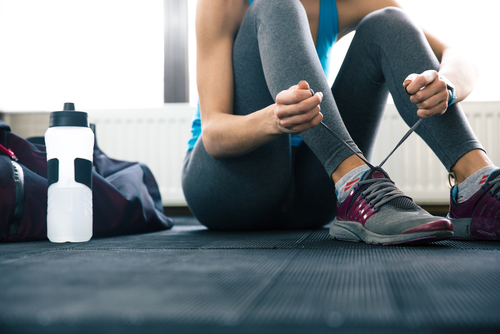
Establishing a Regular Disinfection Schedule
Consistency in disinfection practices is key to maintaining a clean environment. Establish a regular disinfection schedule that includes daily cleaning of high-touch areas and weekly cleaning of other equipment.
Integrate disinfection into daily routines, such as before and after workout sessions, to minimize contamination. Adjust the frequency based on usage patterns and observed cleanliness to ensure all equipment remains sanitary.
Monitoring and Adjusting Practices
Regular assessment helps maintain effective disinfection practices. Monitor the cleanliness of equipment and gather feedback from users regarding the perceived cleanliness.
This information can help identify areas that may need more frequent or thorough cleaning. Adjust disinfection practices as necessary based on observations and feedback to ensure ongoing effectiveness.
Ensuring Proper Drying and Storage
Proper drying and storage of disinfected equipment are essential to prevent contamination and damage. Allow disinfected equipment to air dry fully before use to avoid contact with wet surfaces.
For exercise mats, hang them to dry if possible. Store disinfected equipment in clean, dry areas to maintain hygiene and readiness for use. Proper storage also helps prevent the buildup of moisture, which can lead to mold and mildew.
Safety and Hygiene Considerations
Protecting Users and Staff
Maintaining safety during disinfection is crucial. Encourage users to clean equipment before and after use and provide hand sanitizers and wipes for personal use.
Train staff on proper disinfection techniques, including the safe handling and application of disinfectants. Proper training ensures that staff can effectively clean and disinfect equipment without risking their health.
Managing Disposal of Used Materials
Proper disposal of sanitizing materials prevents secondary contamination. Dispose of used wipes, cloths, and gloves in sealed bags to contain potential contaminants.
Follow local guidelines for disposing of cleaning agents and packaging to minimize environmental harm. Safe disposal practices help maintain cleanliness and prevent the spread of germs from used materials.
Communicating Disinfection Practices
Transparency helps build trust and compliance. Communicate disinfection schedules and protocols clearly to users, displaying notices about the cleanliness of equipment.
Encourage good hygiene practices among users, such as wiping down equipment and using hand sanitizers before and after workouts.
Informing users about the steps taken to maintain cleanliness helps foster a sense of responsibility and cooperation.
How to Disinfect Fitness Equipment and Exercise Mats – Conclusion
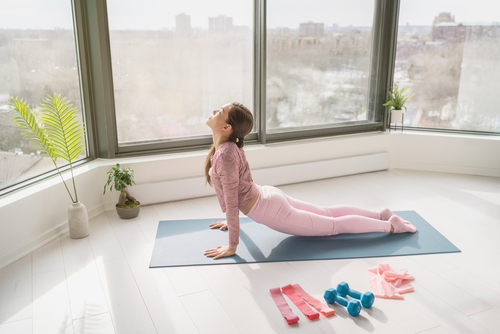
Disinfecting fitness equipment and exercise mats is crucial for creating a hygienic workout environment.
By understanding contamination risks, choosing the right disinfectants, and implementing regular disinfection routines, you can ensure the safety and health of users. Regular disinfection protects against infections and maintains a welcoming and professional gym space!
Are you seeking professional and reliable self-disinfecting coating services in Singapore? Contact us today!




